Best delay pedals 2026: add dimension to your tone with pedals from Boss, Strymon, Electro-Harmonix and more
Explore the best analogue and digital delay pedals for all budgets

1. Quick list
2. Best delay overall
3. Best compact delay
4. Best value delay
5. Most versatile delay
6. Best analogue delay
7. For complex echo
8. Best for mod delay
9. Best for studio delay
10. Affordable multi-delay
11. Buying advice
12. How we choose
For so many guitarists, the noble delay pedal is their secret weapon. Whether it's to add a sense of motion to guitar solos or a much-needed sense of dimension to riffs, delay can undoubtedly take your guitar parts to a whole new level. Of course, delay has evolved hugely throughout the decades. Still, we've made sure to include every type possible in this guide to the best delay pedals - from the distinctive early tape echoes of the '50s to '70s analogue delay and even the digital units of the modern day.
Delay covers a relatively wide range of tonal embellishments, from delicate slapback echo to other-worldly oceans of ambient fascination - hence why we thought we'd run through some of our favourites and the features which make them the best delay pedals of their kind.
If you'd like to read some in-depth, expert buying advice about this time-based effect, then click the link. If you'd rather just get straight to the products, keep scrolling.
Best delay pedals: Quick list
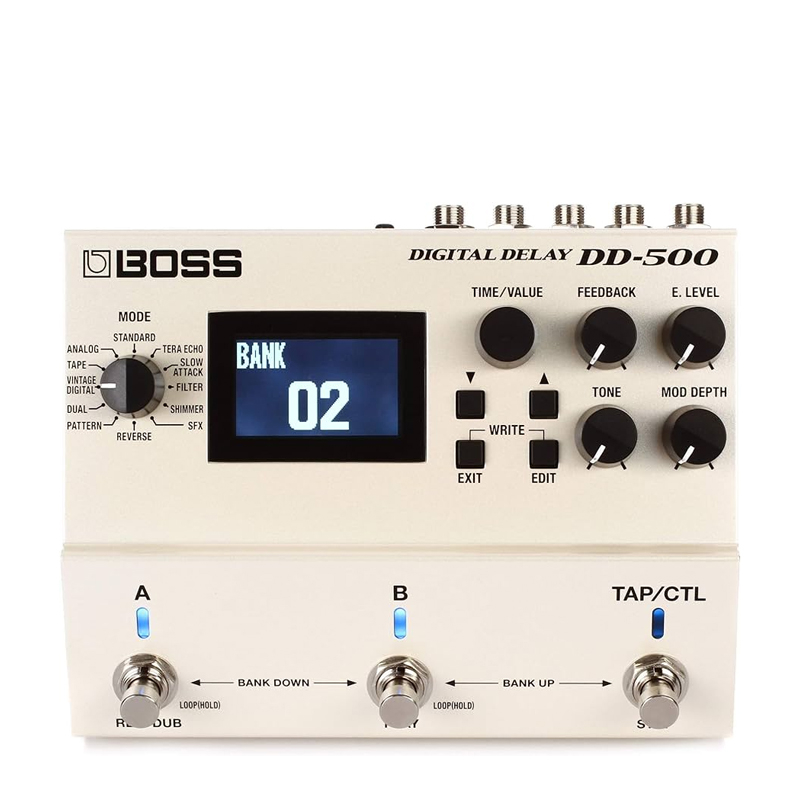
Let’s not beat around the bush – delay is most definitely Boss territory. The Japanese company launched the world’s first mass-produced digital delay pedal, the DD-2, in 1983 and the series continues to thrive to this day. And now, following some stiff competition from other companies like Strymon and Eventide in the high-end market, they’ve really upped their game.

The TC Flashback has been one of the most popular delays of the last decade – which is why you’ll find different versions to suit different needs, from the Mini to the Triple and the X4. This update of the original compact pedal offers the same kind of user-friendly design and some truly lush-sounding delays.

The Canyon marks the company’s first compact, multi-mode offering, packing together 11 delay types, including a 62-second looper and the pitch-shifting Octave mode – a first in an affordable compact. So, while it can’t compete with the sheer horsepower of the DD-500 or Timeline and doesn’t offer stereo outs, it manages to pack a lot into a small amount of space – which is always welcome news for pedal freaks.

There’s a reason why the Timeline is one of the most common pedals found on the boards of professional guitarists. Actually, there are numerous reasons – it’s an all-encompassing delay beast with 12 different types included (‘delay machines’ in TimeLine-speak), plus a stereo 30-second looper and an onboard memory that can store 200 rewritable presets in 100 banks of two.

Using BBD technology, MXR's Carbon Copy has, er, echoes of the old MXR Analog Delay (discontinued in the '80s) – not least in its three control knobs and greenish colouring, albeit in a much spanglier metallic shade this time around. As to be expected, the analog delays are generally richer, darker and less clear than the digital kind – ideal for those who don’t want their repeats to pop out too much or hoping to retain more of a vintage-sounding warmth.

The Echosystem might not look as user-friendly as some of the other bigger delay units out there, but it doesn’t take long to adjust to and is capable of creating a whole universe of ambience. Like the DD-500, it offers a dual mode where you can have two different delays running simultaneously – which opens up endless possibilities for depth and space.
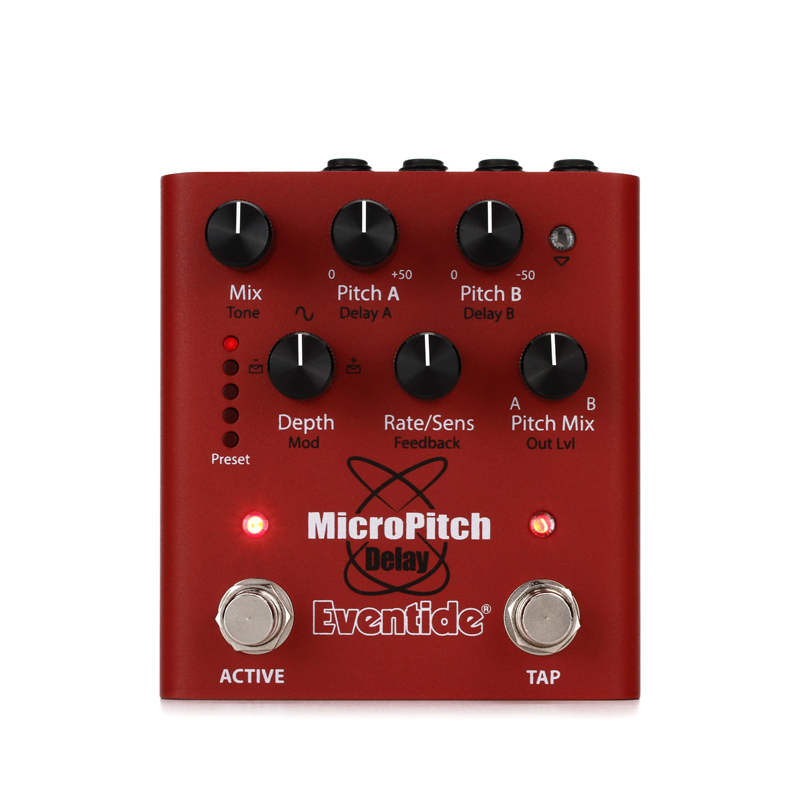
Inspired by the legendary H910 and H949 Harmonizers, the MicroPitch is a pedal with some pretty solid roots. The MicroPitch can go anywhere from ‘always on’ stereo widening, to some pretty spacey modulated delays and huge solo or lead tones with little effort. With the ability to fine-tune both pitches, tweak the wet and dry signal balance and change up your tone to act as a lead boost, the MicroPitch is wholly able to take your tones to another level.

Universal Audio is one of the most exciting newcomers to the pedal market, having made one hell of a name for themselves in the studio world. Known best for their Apollo audio interfaces and plugins, surely they’ll continue their winning streak? The answer is yes. The Starlight Echo Station joins an already hotly contested price bracket, but channelling the spirits of the Echoplex and Memory Man Deluxe make this option a great shout for those who want some slightly more old-school, analog tones than you may find in other high-end delay pedals.

For the serious tweakers and more producer-style guitarists, Source Audio's Nemesis is definitely a front-runner in sheer compatibility, working in conjunction with Source Audio's Neuro app for iOS and Android. You can even use the spare outputs as an external loop, so you can insert another pedal into the feedback loop of the delay line for a whole new dimension of sonic options.
Best delay overall


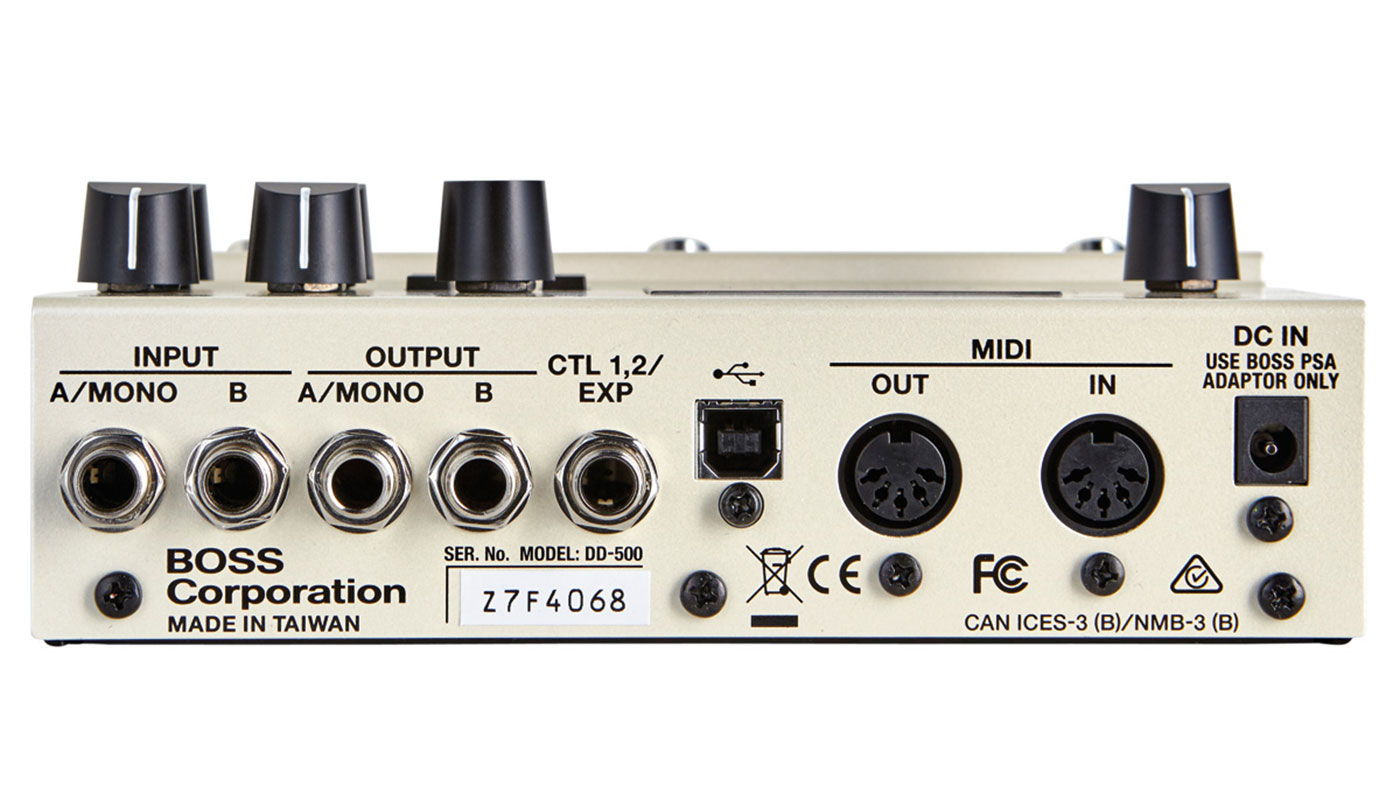
Specifications
Reasons to buy
Reasons to avoid
Let’s not beat around the bush – delay is most definitely Boss territory. The Japanese company launched the world’s first mass-produced digital delay pedal, the DD-2, in 1983 and the series continues to thrive to this day. And now, following some stiff competition from other companies like Strymon and Eventide in the high-end market, they’ve really upped their game.
Meet the DD-500, which boasts a whopping 297 patches to save your carefully crafted tones with the added functionality of running two simultaneously. Then there’s the tap tempo, the ability to freeze notes or manipulate delay rates into sonic infinity, plus a 120-second looper. It’s one of the most powerful delay machines ever made and somehow still manages to undercut most other high-end units in price. Full marks all around.
Read the full Boss DD-500 review
Best compact delay



Specifications
Reasons to buy
Reasons to avoid
The TC Flashback has been one of the most popular delays of the last decade – which is why you’ll find different versions to suit different needs, from the Mini to the Triple and the X4. This update of the original compact pedal offers the same kind of user-friendly design and some truly lush-sounding delays.
It’s also updatable via USB and allows users to beam TonePrints via their phones, which is exactly the kind of forward-thinking that made the Danish company one of the heavyweights in the effects business. Looking for the best delay pedal under £100? This could very well be it.
Read the full TC Electronic Flashback 2 review
Best value delay pedal


Specifications
Reasons to buy
Reasons to avoid
While Boss were the game-changers for digital delay, it was EHX who pioneered the analog units from the decade prior – most famously the Deluxe Memory Man, the first echo/delay unit with no moving parts. In the years since, it’s been used by bands like U2, Radiohead and The Cure.
The Canyon marks the company’s first compact, multi-mode offering, packing together 11 delay types, including a 62 second looper and the pitch-shifting Octave mode – a first in an affordable compact. So, while it can’t compete with the sheer horsepower of the DD-500 or Timeline and doesn’t offer stereo outs, it manages to pack a lot into a small amount of space – which is always welcome news for pedal freaks. One of the best compact delay pedals out there.
Read the full Electro-Harmonix Canyon review
Most versatile delay




Specifications
Reasons to buy
Reasons to avoid
There’s a reason why the Timeline is one of the most common pedals found on the boards of professional guitarists. Actually, there are numerous reasons – it’s an all-encompassing delay beast with 12 different types included (‘delay machines’ in TimeLine-speak), plus a stereo 30-second looper and an onboard memory that can store 200 rewritable presets in 100 banks of two.
And the options range from the more conventional repeats popularised through early analog and digital units to more extreme, pitch-shifted ambient depths that can make your guitar sound like its beaming through space. It’s not one of the cheaper options, granted, but then the smaller units out there won’t cover nearly as much sonic ground. If you’re serious about delay, this or the DD-500 are guaranteed to be the pedals for you.
Read the full Strymon TimeLine review
Best analogue delay




Specifications
Reasons to buy
Reasons to avoid
Using BBD technology, MXR's Carbon Copy has, er, echoes of the old MXR Analog Delay (discontinued in the '80s) – not least in its three control knobs and greenish colouring, albeit in a much spanglier metallic shade this time around. As to be expected, the analog delays are generally richer, darker and less clear than the digital kind – ideal for those who don’t want their repeats to pop out too much or hoping to retain more of a vintage-sounding warmth.
The Carbon Copy boasts 600ms of delay time with optional modulation via a top-mounted switch and a simple, three-knob layout that controls time, mix and repeats. In addition, two internal trim pots offer user-adjustable width and rate control of the modulation for even more tonal options. Consider it a modern and updated version of the 1977 original that quickly became one of the most popular delay units of its era.
Read the full MXR Carbon Copy review
Best for complex echos

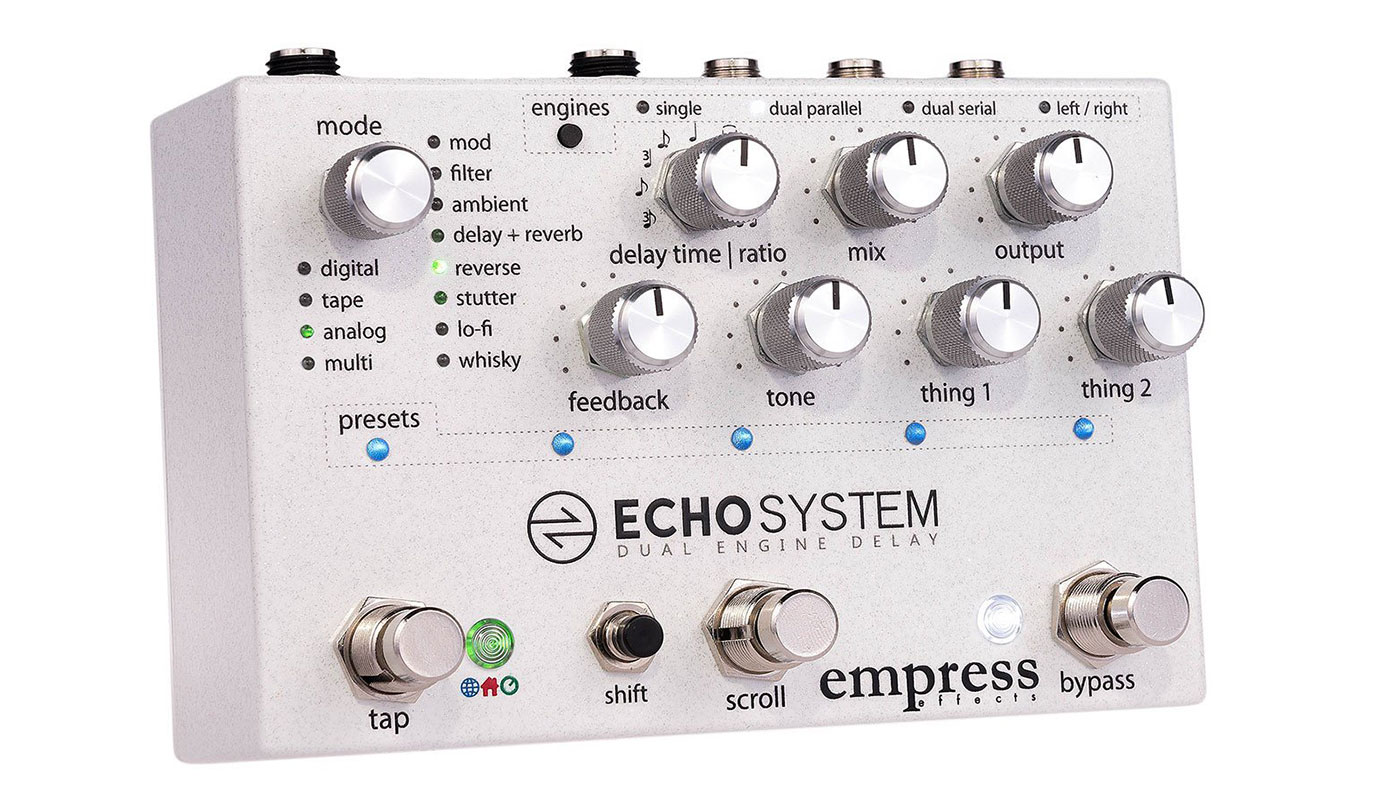

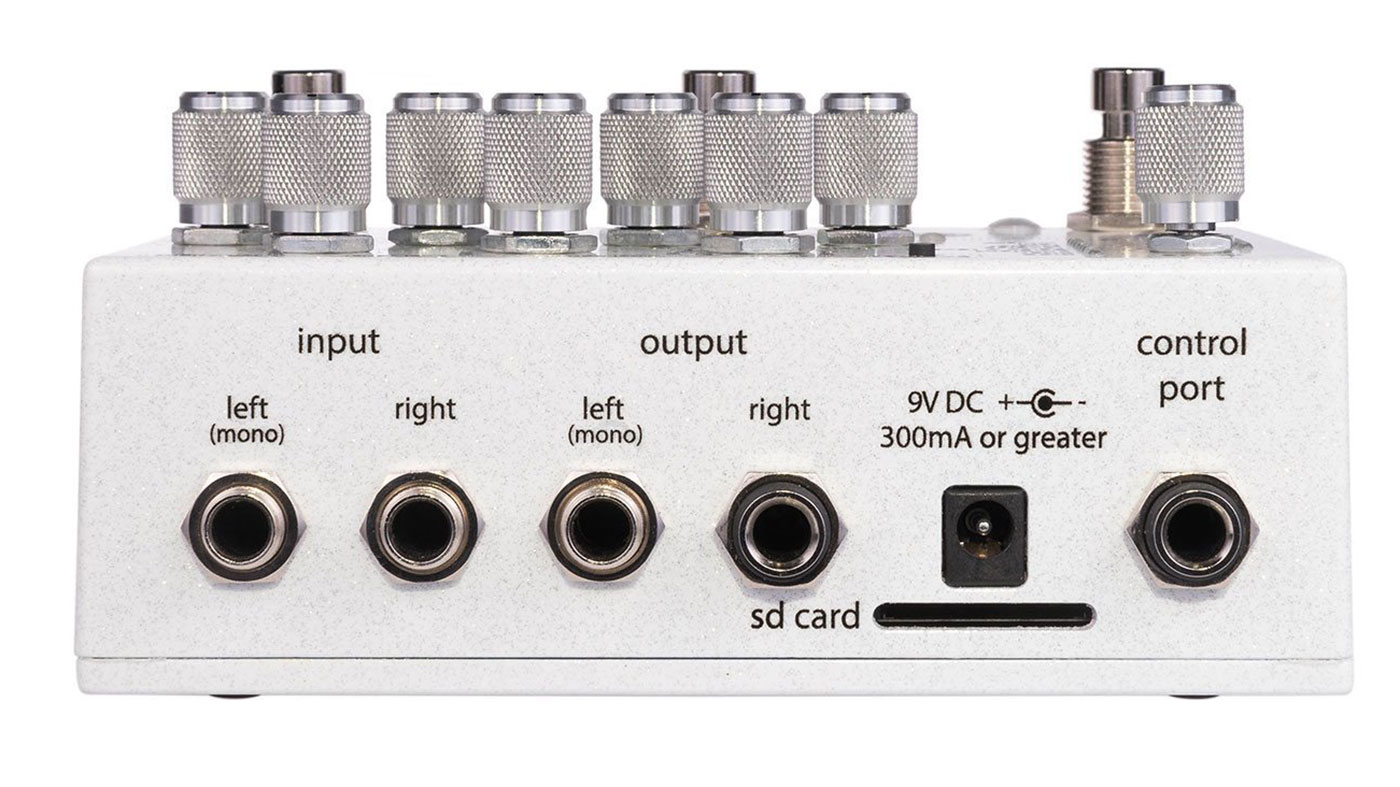
Specifications
Reasons to buy
Reasons to avoid
The Echosystem might not look as user-friendly as some of the other bigger delay units out there, but it doesn’t take long to adjust to and is capable of creating a whole universe of ambience. Like the DD-500, it offers a dual mode where you can have two different delays running simultaneously – which opens up endless possibilities for depth and space.
It’s an incredibly intelligent delay unit once you get to grips with it – and so it should be, sitting at the very top of this best delay pedals list in price. Though it might be a bit overkill for anyone planning to stick to one or two straightforward delay sounds, anyone looking to get really experimental would be wise to give the Echosystem a try.
Read the full Empress Echosystem review
Best for modulated delay


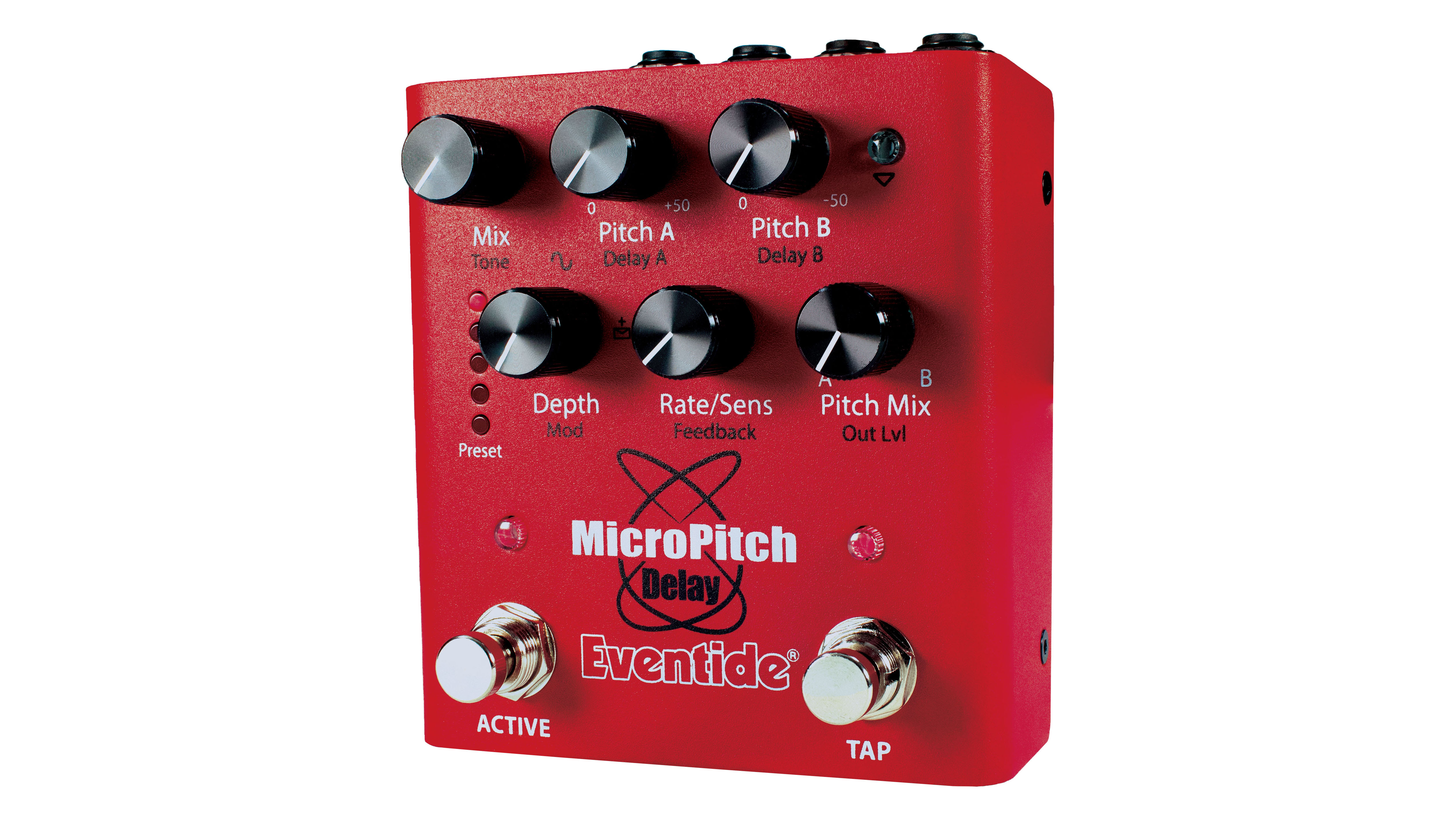

Specifications
Reasons to buy
Reasons to avoid
Eventide has form when it comes to creating some incredibly capable effects pedals. Their H9 Harmonizer and ‘Factor’ series of pedals has shown the industry that they’re ready for the live world, and the MicroPitch delay is proof of this.
Inspired by the legendary H910 and H949 Harmonizers, the MicroPitch is a pedal with some pretty solid roots. The MicroPitch can go anywhere from ‘always on’ stereo widening, to some pretty spacey modulated delays and huge solo or lead tones with little effort.
With the ability to fine-tune both pitches, tweak the wet and dry signal balance and change up your tone to act as a lead boost, the MicroPitch is wholly able to take your tones to another level.
Read the full Eventide MicroPitch Delay review
Best for studio-style delay



Specifications
Reasons to buy
Reasons to avoid
Universal Audio is one of the most exciting newcomers to the pedal market, having made one hell of a name for themselves in the studio world. Known best for their Apollo audio interfaces and plugins, surely they’ll continue their winning streak?
The answer is yes. The Starlight Echo Station joins an already hotly contested price bracket, but channelling the spirits of the Echoplex and Memory Man Deluxe make this option a great shout for those who want some slightly more old-school, analog tones than you may find in other high-end delay pedals.
With optional preamp tone colouring, seemingly endless mode options to switch through, modulation aplenty and the gain-inducing ‘Color’ knob, there’s not very much this delay pedal can’t do. People may find the lack of MIDI and the app-reliance a little frustrating, but we think the tonal quality more than makes up for that.
Read the full Universal Audio Starlight Echo Station review
Best affordable multi-delay




Specifications
Reasons to buy
Reasons to avoid
For the serious tweakers and more producer-style guitarists, Source Audio's Nemesis is definitely a front-runner in sheer compatibility, working in conjunction with Source Audio's Neuro app for iOS and Android. You can even use the spare outputs as an external loop, so you can insert another pedal into the feedback loop of the delay line for a whole new dimension of sonic options.
The 12 different delay engines offer a range of sounds, from classic to more modern and experimental tones, covering virtually all musical needs with stereo I/O and MIDI connectivity. And considering it’s one of the more all-encompassing and higher-end delays in this list, it still manages to be pretty affordable.
Read the full Source Audio Nemesis review
Best delay pedals: Buying advice

Which type of delay is best for you?
Digital delays generally have cleaner echoes, analogue delays sound richer and darker, and tape delays degrade with each repeat. Some lead players might just need one simple setting for every solo, and find they’re better suited to something like the MXR Carbon Copy – an all-analogue and true bypass favourite, though admittedly more of a one-trick pony compared to other options.
Some guitarists prefer to use multiple delays running simultaneously throughout each section of every song – which means they’ll be needing something high-powered with dual modes and options for reverse, ping-pong and pad echoes to turn their guitar into a whole new instrument.
Those looking to get extra experimental - such as post indie or progressive/atmospheric rock players will find themselves better suited to something more modern, with options for more affected and extreme delay times.
What features should I look for in a delay pedal?
For the most part, delay pedals are pretty simple, offering controls for volume, delay time and feedback - and for most of us, that's enough. That said, as the delay pedal evolved through time, as too did the features tucked away inside.
If you like your delay to be precisely in time, you may want to find a unit that offers tap-tempo. As the name suggests, this feature allows you to manually input the tempo of the delay by simply tapping a switch with your foot. Some modern delay pedals offer the ability to adjust the tempo - and other parameters - via MIDI, meaning you can have your delay pedal respond in real-time to control information being sent from a laptop, switcher or another pedal.
Do you wish your delay had even more movement? Well, perhaps you'd like a unit with a built-in modulation switch. This modulation adds a chorus effect to just the repeats, bringing an extra dimension to the sound. The MXR Carbon Copy does this very well, and in some ways, it's reminiscent of the worble found in retro tape delays.
Where should the delay go on your pedalboard?
Really, there are no rules when it comes to stompbox placement on a 'board, but there is a general order most guitarists stick to. Now, the sequence most players favour is the tuner and other utility pedals first, then dynamic effects such as compressors, followed closely by the primary source of overdrives or distortion. Next, you'll want a boost for solos, then your time-based effects, such as the delay and your reverb pedal.
This order will give you the most versatile board, but we do suggest moving pedals around to generate more unique sounds. For example, why not try your boost before your drive to alter the tone of that pedal, or perhaps try your delay and reverb in the FX loop of your amp to create a more subtle tone.
How we choose pedals

Here at MusicRadar, we are experts in our field, with many years of playing, creating and product testing between us. We live and breathe everything music gear related, and we draw on this knowledge and experience of using products in live, recording and rehearsal scenarios when selecting the products for our guides.
When choosing what we believe to be the best delay pedals available right now, we combine our hands-on experience, user reviews and testimonies and engage in lengthy discussions with our editorial colleagues to reach a consensus about the top products in any given category.
First and foremost, we are musicians, and we want other players to find the right product for them. So we take into careful consideration everything from budget to feature set, ease of use and durability to come up with a list of what we can safely say are the best delay pedals on the market right now.
Find out more about how we test music gear and services at MusicRadar.
Related buyer's guides
MusicRadar's got your back
- Dig into more dirt with the best fuzz pedals for guitar
- Go harder with the best distortion pedals
- Try our pick of the best chorus pedals for guitar
- On a tight budget? Here are the best cheap guitar pedals
Want all the hottest music and gear news, reviews, deals, features and more, direct to your inbox? Sign up here.
Amit has been writing for titles like Total Guitar, MusicRadar and Guitar World for over a decade and counts Richie Kotzen, Guthrie Govan and Jeff Beck among his primary influences. He's interviewed everyone from Ozzy Osbourne and Lemmy to Slash and Jimmy Page, and once even traded solos with a member of Slayer on a track released internationally. As a session guitarist, he's played alongside members of Judas Priest and Uriah Heep in London ensemble Metalworks, as well as handling lead guitars for legends like Glen Matlock (Sex Pistols, The Faces) and Stu Hamm (Steve Vai, Joe Satriani, G3).
- James Farmer
- Daryl RobertsonSenior Deals Writer
